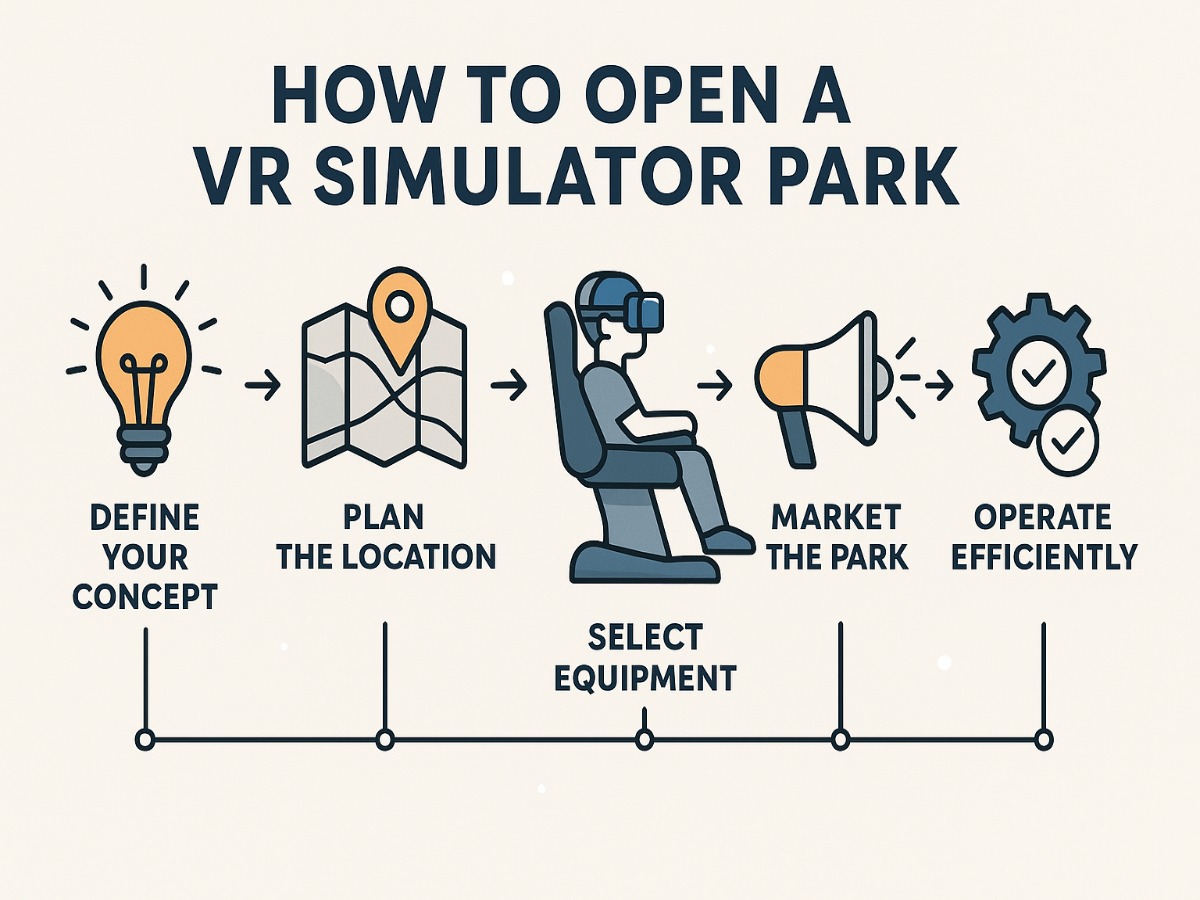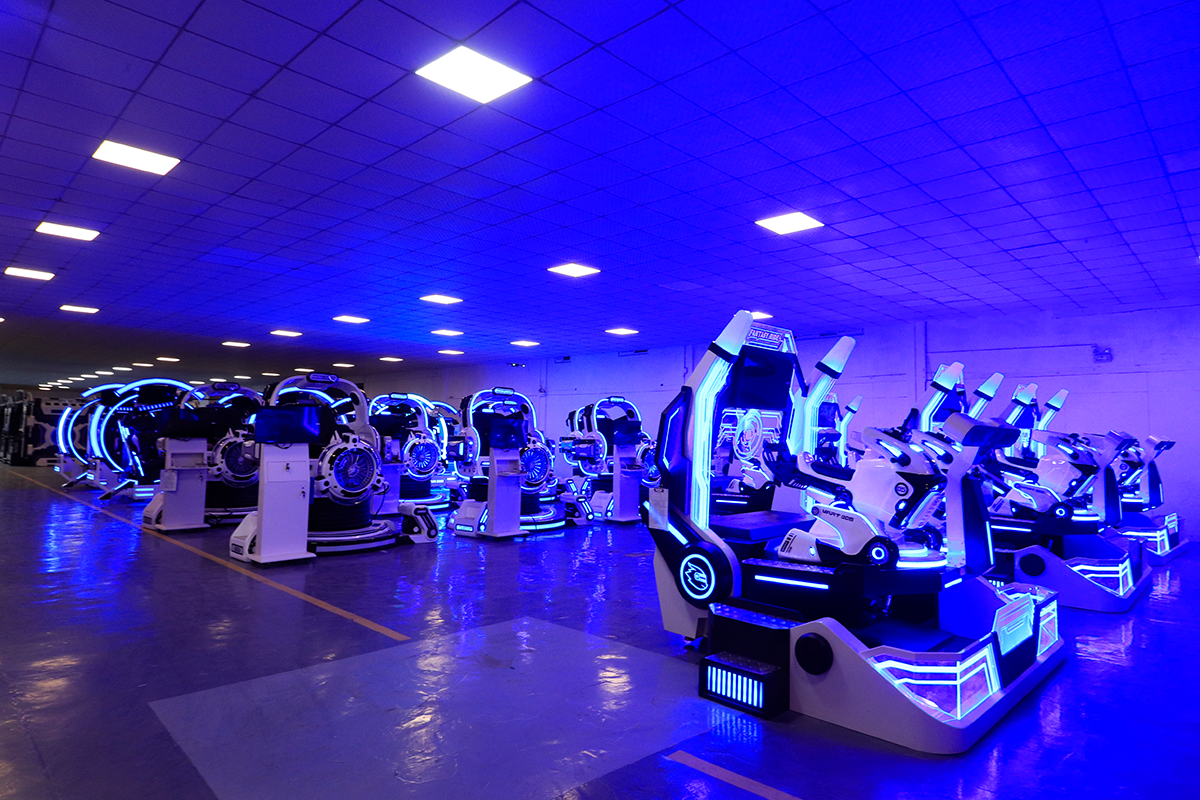Introduction
Virtual Reality (VR) technology is rapidly transforming the global entertainment industry. More and more entrepreneurs are looking to open VR simulator parks to deliver immersive, high-tech experiences to their customers.
If you’re planning to start your own VR simulator park, this article will walk you through every key step — from location planning to equipment selection, theme design, and daily operations.
At VART VR Simulator, we also provide a full-scale VR simulator customization service — covering equipment selection, scene design, installation, and long-term support. This guide will show you not only how to open a VR theme park, but how to do it efficiently, safely, and profitably.
Step 1 – Define Your Concept and Target Audience
Before any investment, defining your park’s concept and audience is essential.
-
Theme Direction: Decide whether your park focuses on family fun, adrenaline-packed experiences, or futuristic sci-fi themes.
-
Target Visitors: Families, young adults (18–35), or corporate groups all have different expectations.
-
Project Size: Will it be a compact VR corner with a few machines, or a large-scale full VR simulator park with multiple themed zones?
Our VR simulator customization service helps you analyze your market and design a setup that perfectly matches your goals. With clear positioning, your later steps — from equipment purchase to marketing — become easier and more precise.
Step 2 – Choose the Right Location and Plan the Space
What Makes a Great Location?
A VR simulator park thrives on accessibility and visibility.
-
High foot traffic: Shopping malls, cinemas, and entertainment districts work best.
-
Space requirement: A full-scale park typically needs at least 500 m², allowing multiple simulator zones, a waiting area, and a control room.
-
Infrastructure: Ensure stable power supply, ventilation, and fire safety compliance.
The right venue layout helps reduce future renovation costs and ensures a smooth flow of visitors.
Suggested Layout Plan
| Zone | Recommended Area | Purpose |
|---|---|---|
| Entrance & Reception | 20-30% | Ticketing, resting, small retail |
| Experience Zone | 50-60% | VR simulators, motion platforms, multiplayer setups |
| Control & Maintenance Room | 10-15% | Technical systems, servers, storage |
| Support Area | Remaining space | Locker rooms, toilets, safety area |
Our VR simulator customization team provides professional CAD floor plans and wiring layouts, ensuring every square meter is efficiently used.
Step 3 – Select the Right Equipment
Popular Types of VR Simulators
A diverse range of VR simulators makes your park engaging and repeat-worthy:
-
VR Motion Seats (5D/7D/9D): Immersive with vibration and movement effects.
-
VR Racing or Flying Simulators: High-speed, multiplayer competition experiences.
-
360° Rotating Platforms: Extreme realism and thrill.
-
Multiplayer VR Game Pods: Perfect for group fun and social media sharing.
Recent studies show that interactive simulator zones increase visitor retention by over 35% compared to traditional arcade setups (source: VRSpace Report, 2024).
Why Choose Full VR Simulator Customization?
By choosing our complete VR simulator customization service, you gain:
-
Tailored solutions from concept to installation;
-
Professional equipment matching your space and budget;
-
On-site setup, calibration, and safety testing;
-
Long-term maintenance, software updates, and theme refreshes.
This one-stop service eliminates the hassle of coordinating multiple vendors and ensures your park opens faster and runs more reliably.
Step 4 – Build Immersive Themes and User Flow
Theme Design Enhances Your Brand
A themed environment turns a simple attraction into a memorable experience.
Popular concepts include:
-
Space Adventure – explore galaxies in zero gravity;
-
Future Cyber City – neon-lit tech worlds;
-
Ancient Ruins Quest – treasure hunting with motion platforms.
Through our customization service, we can match the look and lighting of your park to your brand identity — from wall graphics to simulator shells.
Smooth Visitor Experience Flow
-
Check-in and safety briefing.
-
VR headset fitting and short instructions.
-
5-10 minute immersive VR session.
-
Photo/selfie zone and souvenir shop.
-
Optional re-experience or membership sign-up.
An optimized flow ensures safety, comfort, and repeat engagement.
Step 5 – Staff Training and Safety Measures
Essential Roles to Train
-
Front Desk Staff: Ticketing and customer guidance.
-
VR Operators: Help users wear devices, manage simulator timing.
-
Technicians: Equipment inspection, software updates, troubleshooting.
We provide operation manuals and training sessions within our customization service package — ensuring your team runs efficiently from day one.
Safety First
-
Set clear time limits (5–10 minutes) for new users.
-
Provide emergency exits and clear signage.
-
Include health disclaimers for sensitive users (e.g. pregnancy, heart conditions).
Safety not only builds trust but protects your long-term reputation.
Step 6 – Create a Profitable Pricing and Operation Model
Pricing Example
Let’s take a mid-size park with 5 simulators, each operating 8 hours per day.
-
Each session lasts 10 minutes.
-
Each ticket costs $10–12.
-
Total potential: 5 machines × 48 sessions × $10 = $2,400/day.
This projection helps investors understand daily revenue potential and ROI.
Flexible Business Models
-
Pay-per-ride: Simple and transparent for visitors.
-
Membership plans: Encourage loyalty and repeat visits.
-
Group bookings: Corporate events, birthdays, or school trips.
Using a mix of these models maximizes both peak-time and off-peak income.
Step 7 – Marketing and Customer Growth
Build Local Awareness
Create a strong local presence — list your VR park on Google Maps, TripAdvisor, and local directories. Add real photos, clear pricing, and encourage visitors to leave reviews. A good rating (4.6 or higher) quickly boosts credibility and foot traffic.
Offer Simple Promotions
Attract different audiences with flexible packages:
-
Family or student discounts on weekdays.
-
Birthday or team-building party bundles.
-
Monthly passes or prepaid cards for loyal visitors.
Small, time-limited offers help maintain excitement and repeat visits.
Use Social Media to Share Real Experiences
Post short clips of happy players, group photos, or themed events on Instagram and Facebook. Use local hashtags and tag your city to reach nearby audiences. Encourage guests to share their own posts for small rewards or discounts.
Step 8 – Monitor Data and Keep Upgrading
Track Key Performance Indicators
-
Daily and monthly visitor numbers;
-
Device utilization rate;
-
Average spending per visitor;
-
Repeat visitor rate.
Analyzing these KPIs helps you adjust ticket pricing and content strategy.
Maintain and Refresh Content
To stay competitive:
-
Inspect hardware weekly and clean optics regularly;
-
Update software and games every 3–6 months;
-
Rotate new VR themes seasonally.
Our team provides remote technical support and continuous upgrades as part of the full VR simulator customization service, so your park always feels new.
Conclusion & Call to Action
Launching a VR simulator park may sound complex — but with the right partner, it becomes a rewarding venture. From concept design to installation and maintenance, our all-in-one VR simulator customization service helps you save time, reduce costs, and start operating faster.
Ready to start?Visit VART VR Simulator or contact our experts to discuss your project. Let’s turn your idea into a real-world VR destination!
Post time: Oct-27-2025


